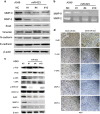Hsa-miR-623 suppresses tumor progression in human lung adenocarcinoma
- PMID: 27685632
- PMCID: PMC5059863
- DOI: 10.1038/cddis.2016.260
Hsa-miR-623 suppresses tumor progression in human lung adenocarcinoma
Erratum in
-
Hsa-miR-623 suppresses tumor progression in human lung adenocarcinoma.Cell Death Dis. 2017 May 25;8(5):e2829. doi: 10.1038/cddis.2017.254. Cell Death Dis. 2017. PMID: 28542138 Free PMC article.
-
Correction to: Hsa-miR-623 suppresses tumor progression in human lung adenocarcinoma.Cell Death Dis. 2018 Aug 6;9(8):829. doi: 10.1038/s41419-018-0880-7. Cell Death Dis. 2018. PMID: 30082717 Free PMC article.
Retraction in
-
Retraction Note: Hsa-miR-623 suppresses tumor progression in human lung adenocarcinoma.Cell Death Dis. 2019 Jan 25;10(2):60. doi: 10.1038/s41419-019-1300-3. Cell Death Dis. 2019. PMID: 30683838 Free PMC article.
Abstract
Our previous study revealed that Ku80 was overexpressed in lung cancer tissues and hsa-miR-623 regulated the Ku80 expression; however, the detailed function of hsa-miR-623 in lung cancer was unclear. We identified that hsa-miR-623 bound to the 3'-UTR of Ku80 mRNA, thus significantly decreasing Ku80 expression in lung adenocarcinoma cells. Hsa-miR-623 was downregulated in lung adenocarcinoma tissues compared with corresponding non-tumorous tissues, and its expression was inversely correlated with Ku80 upregulation. Downregulation of hsa-miR-623 was associated with poor clinical outcomes of lung adenocarcinoma patients. Hsa-miR-623 suppressed lung adenocarcinoma cell proliferation, clonogenicity, migration and invasion in vitro. Hsa-miR-623 inhibited xenografts growth and metastasis of lung adenocarcinoma in vivo. Ku80 knockdown in lung adenocarcinoma cells suppressed tumor properties in vitro and in vivo similar to hsa-miR-623 overexpression. Further, hsa-miR-623 overexpression decreased matrix metalloproteinase-2 (MMP-2) and MMP-9 expression levels, with decreased ERK/JNK phosphorylation. Inhibition of hsa-miR-623 or overexpression of Ku80 promoted lung adenocarcinoma cell invasion, activated ERK/JNK phosphorylation and increased MMP-2/9 expressions, which could be reversed by ERK kinase inhibitor or JNK kinase inhibitor. In summary, our results showed that hsa-miR-623 was downregulated in lung adenocarcinoma and suppressed the invasion and metastasis targeting Ku80 through ERK/JNK inactivation mediated downregulation of MMP-2/9. These findings reveal that hsa-miR-623 may serve as an important therapeutic target in lung cancer therapy.
Figures







References
-
- Ferlay J, Shin HR, Bray F, Forman D, Mathers C, Parkin DM. Estimates of worldwide burden of cancer in 2008: GLOBOCAN 2008. Int J Cancer 2010; 127: 2893–2917. - PubMed
-
- Siegel R, Naishadham D, Jemal A. Cancer statistics, 2012. CA Cancer J Clin 2012; 62: 10–29. - PubMed
-
- Gupta GP, Massague J. Cancer metastasis: building a framework. Cell 2006; 127: 679–695. - PubMed
-
- Mehlen P, Puisieux A. Metastasis: a question of life or death. Nat Rev Cancer 2006; 6: 449–458. - PubMed
-
- Ross GM, Eady JJ, Mithal NP, Bush C, Steel GG, Jeggo PA et al. DNA strand break rejoining defect in xrs-6 is complemented by transfection with the human Ku80 gene. Cancer Res 1995; 55: 1235–1238. - PubMed
Publication types
MeSH terms
Substances
LinkOut - more resources
Full Text Sources
Other Literature Sources
Medical
Research Materials
Miscellaneous

